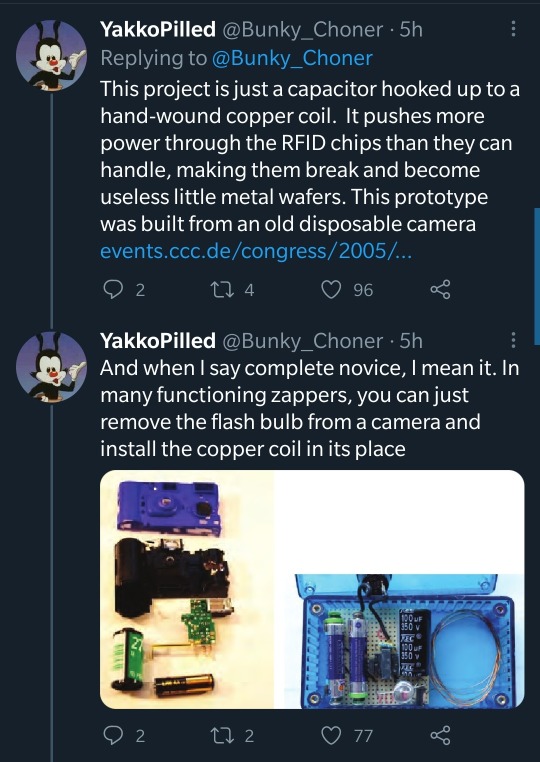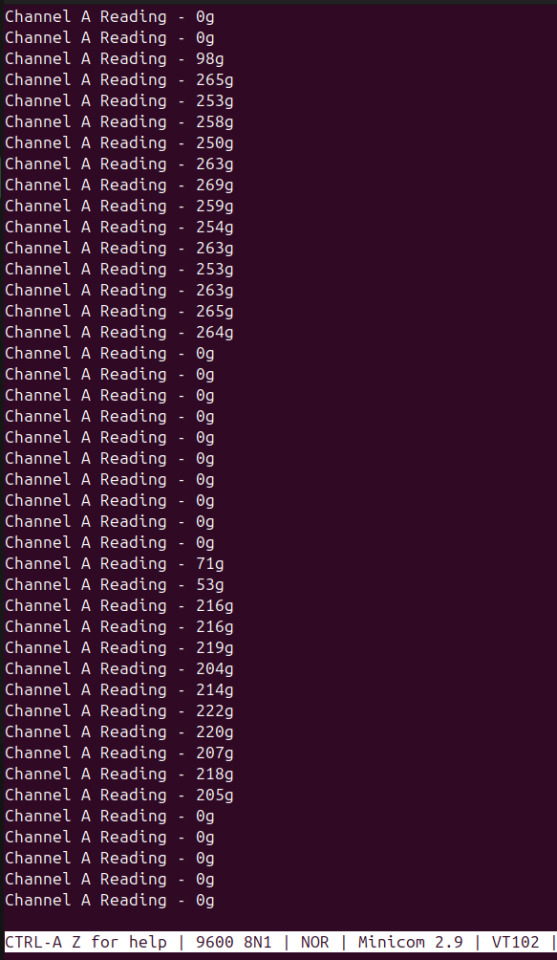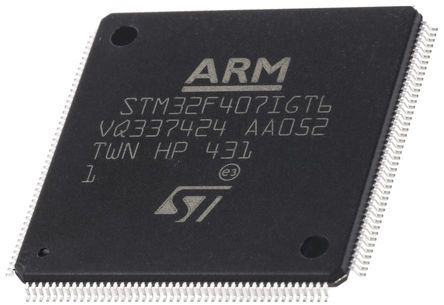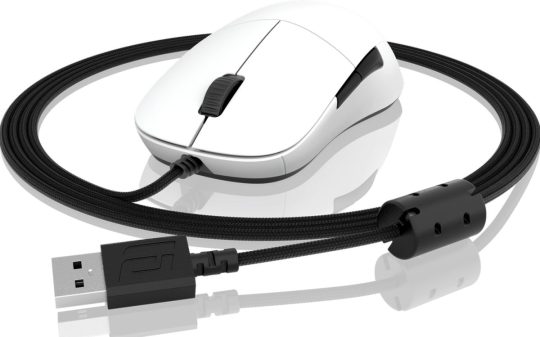#STM32 MCU
Explore tagged Tumblr posts
Text
youtube
STMicroelectronics: ST29056_STM32WBA MCU Series
https://www.futureelectronics.com/en/npi/stmicroelectronics-stm32wba-series-microcontrollers . STMicroelectronics: ST29056_STM32WBA MCU Series. Discover the first STM32 MCU based on a wireless Arm Cortex-M33 core running up to 100MHz, with a radio enabling +10 dBm in output power. https://youtu.be/wXCv4iYndWQ
1 note
·
View note
Text
youtube
STMicroelectronics: ST29056_STM32WBA MCU Series
https://www.futureelectronics.com/en/npi/stmicroelectronics-stm32wba-series-microcontrollers . STMicroelectronics: ST29056_STM32WBA MCU Series. Discover the first STM32 MCU based on a wireless Arm Cortex-M33 core running up to 100MHz, with a radio enabling +10 dBm in output power. https://youtu.be/wXCv4iYndWQ
0 notes
Video
youtube
MCU STMicroelectronics #stm8s #STM8S105K4T6 #DP83848IVVX #TI #STM32 #STM32F405RGT6 #ST #chip #electronic components #ICGOODFIND
1 note
·
View note
Text
Connect STM32C0 to computer
Notes to self because I'm sure I'll forget this in three months time.
STLink v2 (generic cheap clone) doesn't seem to work (or I'm being stupid)
STLink v3 MINIE is the weapon of choice
Does not have any useful plugs whatsoever but you can solder wires to the edge connector fingers at the bottom
That feels wrong but honestly when am I going to design a board that's gonna need those? My stuff is for model railroads I don't have space for an edge connector like that
TMS to SWDIO
CLK to SWCLK
RST to NRST (no special logic necessary, yes even though NRST is negated, it seems they didn't have space for that extra letter on the board). This is optional according to ST, and in my case the cable came off and everything still worked, so, you know
GND to GND
VCC to your target 3.3V output! The thing you have on your board to power your MCU. STLink v3 MINIE uses this only to find out what you're running the MCU at. Implied in this: You can't use this STLink to power your target board, you always have to provide external power.
Most important letter in STLink is the L.
It's really not that difficult once you've figured this all out, and thankfully I had ordered this STLink v3 on a whim earlier, but it's not directly apparent. I'm sure there's an application note or something that will tell you this even better.
#programming#microelectronics#electronics#mcu#stm32#stlink#stm32c0#STM32C031C4#STM32C031C4G6#say what you want but 48 MHz for the price of an ATTiny?#I don't even need 48 MHz for my model railroad train car lighting but if I can get it I mean why not
1 note
·
View note
Text
Configuring Zephyr: A Deep Dive into Kconfig
We presented The Zephyr Project RTOS and illustrated a personal best practice for beginning with "Zephyr" in an earlier blog post. A custom West manifest file is a great way to guarantee that your code is always at a known baseline when you begin development, as you saw in that blog post. Following the creation of your custom manifest file and the establishment of your baseline repositories using West, what comes next in your Zephyr journey?

Enabling particular peripherals, features, and subsystems is one of the first steps in putting embedded software into practice. Some MCU manufacturers, like STM32, Microchip, and TI, have tools in their IDEs that let developers add subsystems to their codebase and enable peripherals in their projects. These tools, however, are closely related to the MCUs that the vendors sell. Applying these tools' functionality to other MCUs is challenging, if not impossible.
However, we can enable a specific MCU subsystem or feature using a vendor-neutral mechanism provided by The Zephyr Project RTOS. For people like me who don't like GUIs, this mechanism can be used with a command line. The name of this utility is "Kconfig." I'll go over what Kconfig is, how it functions, and the various ways we can use it to incorporate particular features and subsystems into our Zephyr-based project in this blog post.
WHAT IS KCONFIG?
Kconfig is still utilized today as a component of the kernel compilation process, having been initially created as part of the Linux kernel. Kconfig has a particular grammar. Although fascinating, the specifics of how Kconfig is implemented in the Linux kernel are outside the purview of this blog post. Alternatively, if you're interested, you can read my article here: (https://www.linux-magazine.com/Issues/2021/244/Kconfig-Deep-Dive), which walks through the Kconfig source code. However, after seeing an example, it's simple to become familiar with the format of a "Kconfig"—the slang term for a specific configuration option. The Kconfig system consists of three primary components.
First, there is the collection of Kconfig files scattered across different OS codebase directories. For example, if we look under "drivers/led" within the Zephyr codebase, we see a file named Kconfig with the following contents: menuconfig LED bool "Light-Emitting Diode (LED) drivers" help Include LED drivers in the system configurationif LED...config LED_SHELL bool "LED shell" depends on SHELL help Enable LED shell for testing.source "drivers/led/Kconfig.gpio"...endif # LED
Using the if statement, the line that begins with "menuconfig" tells the Kconfig system that "LED" contains a number of feature options that are only visible if the "LED" feature is enabled. The user can then activate the "LED_SHELL" option if the "LED" feature is enabled. The result of this configuration option is a Boolean, which determines whether this feature is enabled or disabled, as the line that follows shows. If a configuration option refers to a particular configuration parameter, the result can also be an integer in addition to a Boolean. The line that starts with "depends" indicates that in order for the "LED_SHELL" feature to be visible, the "SHELL" feature needs to be enabled. As a result, only after the "LED" and "SHELL" features have been enabled will the "LED_SHELL" feature become visible. A more detailed explanation of the feature can be found in the two lines that begin with "help". Last but not least, the final line before the "endif" lets us refer to additional Kconfig files, which aids in classifying components. As though they were copied and pasted, the features of the referenced file are present in the current file. It is crucial to remember that the path to "source" comes from the Zephyr codebase's root.
HOW SHOULD YOU USE KCONFIG?
A collection of applications that enable users to enable or disable the features listed in all Kconfig files make up the second component of the Kconfig infrastructure. Zephyr provides a Visual Studio Code extension that enables users to carry out this task with a graphical user interface. For command line enthusiasts like myself, the VS Code extension provides an alternative to utilizing a graphical user interface. In order to configure Zephyr appropriately, the extension can accept a file, which is the final component of the Kconfig infrastructure and contains a set of configuration options that can be turned on or off. The following snippet shows an example. CONFIG_BT=yCONFIG_BT_PERIPHERAL=yCONFIG_BT_GATT_CLIENT=yCONFIG_BT_MAX_CONN=1CONFIG_BT_L2CAP_TX_MTU=250CONFIG_BT_BUF_ACL_RX_SIZE=254
There is nothing complicated about the file format. "CONFIG_" appears at the start of each line, and then the configuration option's name. After the "=" symbol, the line either ends with a "y" to activate the feature or a "n" to deactivate it. In the example above, we configure the stack parameters and activate the Bluetooth stack in Zephyr along with specific stack features. "prj. conf," which contains user-defined features, is the default file in the majority of Zephyr-based applications.
CONCLUSION
The Zephyr Project RTOS provides a robust, vendor-neutral mechanism called the Kconfig infrastructure that allows us to fully configure our entire application. It can be used to control particular subsystems and peripherals within the MCU in addition to turning on or off individual stacks within the RTOS and setting configuration parameters.
Ready to bring your embedded systems to life with optimized configurations and robust solutions? We specialize in hardware design and software development tailored to your project needs. Whether you're configuring peripherals or diving deeper into Kconfig for your Zephyr-based applications, our experts are here to support you every step of the way.
👉 Contact Us Today and let's transform your embedded ideas into reality!
2 notes
·
View notes
Text
EXG Synapse — DIY Neuroscience Kit | HCI/BCI & Robotics for Beginners
Neuphony Synapse has comprehensive biopotential signal compatibility, covering ECG, EEG, EOG, and EMG, ensures a versatile solution for various physiological monitoring applications. It seamlessly pairs with any MCU featuring ADC, expanding compatibility across platforms like Arduino, ESP32, STM32, and more. Enjoy flexibility with an optional bypass of the bandpass filter allowing tailored signal output for diverse analysis.
Technical Specifications:
Input Voltage: 3.3V
Input Impedance: 20⁹ Ω
Compatible Hardware: Any ADC input
Biopotentials: ECG EMG, EOG, or EEG (configurable bandpass) | By default configured for a bandwidth of 1.6Hz to 47Hz and Gain 50
No. of channels: 1
Electrodes: 3
Dimensions: 30.0 x 33.0 mm
Open Source: Hardware
Very Compact and space-utilized EXG Synapse
What’s Inside the Kit?:
We offer three types of packages i.e. Explorer Edition, Innovator Bundle & Pioneer Pro Kit. Based on the package you purchase, you’ll get the following components for your DIY Neuroscience Kit.
EXG Synapse PCB
Medical EXG Sensors
Wet Wipes
Nuprep Gel
Snap Cable
Head Strap
Jumper Cable
Straight Pin Header
Angeled Pin Header
Resistors (1MR, 1.5MR, 1.8MR, 2.1MR)
Capacitors (3nF, 0.1uF, 0.2uF, 0.5uF)
ESP32 (with Micro USB cable)
Dry Sensors
more info:https://neuphony.com/product/exg-synapse/
2 notes
·
View notes
Text
Buy a flipper0 before they ban them



88K notes
·
View notes
Text
Adapting HX711 modules for 3.3V Operation
The HX711 is a versatile integrated circuit (IC) designed for precision analog-to-digital (A/D) conversion, particularly suited for strain gauge load cell applications. It features a 24-bit A/D converter with a differential input stage capable of handling both single-ended and differential input signals. Additionally, this device offers adjustable gain amplification to accommodate various load cell sensitivities.

A common module based on the HX711 available in the market, including on AliExpress, is shown below. This module utilizes its internal analog supply regulator, which ensures a stable analog supply (AVDD) for the ADC and other internal components. The output voltage of the regulator (AVDD) is calculated using the following formula: VAVDD = VBG × (R1 + R2) / R2.

According to the electrical characteristics listed in the datasheet, the reference bypass voltage (VBG) is 1.25V. For the modules mentioned, R1 is set at 8.2kΩ and R2 at 20kΩ. By substituting these values into the formula, we calculate AVDD to be approximately 4.29V.

The HX711 IC operates within a voltage range of 2.6V to 5.5V. However, many HX711 modules on the market come with an internal voltage regulator that outputs approximately 4.29V. This can pose challenges when using the module with 3.3V microcontrollers. Furthermore, the datasheet specifies that the output voltage of the regulator should be at least 100mV lower than the supply voltage (VSUP), making the current regulator's output voltage incompatible with 3.3V supply voltages.

To address this, we need to ensure that AVDD is within the 2.6V to 3.2V range to make the module compatible with both 3.3V and 5V systems. After conducting some calculations, we determined that replacing R1 with 10kΩ and R2 with either 15kΩ or 12kΩ would be ideal. Using a 15kΩ resistor gives an AVDD of 3.1V, while using a 12kΩ resistor reduces it to 2.75V. In one of our experimental boards, we opted to replace R2 with a 12kΩ resistor.

As a further test, we lowered the AVDD to approximately 1.6V, and at this voltage, the HX711 still produced the correct results in our test setup. Interestingly, we observed that swapping R1 and R2 allows us to achieve an AVDD of 1.76V. To test this, we swapped R1 (8.2kΩ) and R2 (20kΩ) in one of the modules, and after applying a 5V supply, we noted that the AVDD returned at 1.65V, with the HX711 still providing correct outputs.

To evaluate the boards, we created a quick prototype using the STM32F405 MCU. In this prototype, we powered the HX711 module with 3.3V and directly connected its I/O pins to the STM32 GPIO pins.
For interaction with the module, we utilized the HX711 library provided at https://github.com/PCov3r/HX711-STM32-Library. The source code for our test firmware is available here.

After making the above modifications, all modules produce a stable output at 3.3V. We tested these modules with both 3.3V and 5V MCUs, using 5kg, 10kg, and 20kg load cells, and it operated correctly across all these combinations.
0 notes
Text
Mastering PCB Reverse Engineering: Unlocking the Secrets of Complex Circuitry
In the world of electronics, the demand for precise, efficient, and high-quality PCB (Printed Circuit Board) reverse engineering services is growing exponentially. This intricate process involves deconstructing a PCB to uncover its design, components, and functionality, enabling the replication or modification of complex electronic systems. Let's delve into the fascinating realm of PCB reverse engineering and explore its multifaceted services and applications.
The Expertise in PCB Reverse Engineering
Experts in PCB reverse engineering leverage professional software and advanced techniques to achieve a 100% success rate in copying and modifying PCBs. These specialists handle high-difficulty and multi-layer PCBs with blind holes, ensuring the cloned boards are indistinguishable from the originals.
Unlocking IC Chips
One of the standout services in PCB reverse engineering is the ability to unlock various IC (Integrated Circuit) chips. This includes MCUs (Microcontroller Units) from brands like ARM, STM32, GD32, Samsung, RENESAS, NEC, and TI. The unlocking process is meticulously executed without damaging the original chips, allowing for seamless integration and functionality in secondary electronic product development.
Comprehensive PCBA and SMT Services
PCB reverse engineering goes beyond mere replication. It encompasses a full suite of services, including:
PCB Design: Crafting new designs or modifying existing ones based on reverse-engineered data.
Sample Debugging: Ensuring the prototypes function correctly before mass production.
PCBA Welding: Precision welding for secure component attachment.
Component Selection and IC Procurement: Sourcing high-quality components to match the original design.
High-Precision Board Making: Producing boards with exact specifications to meet industry standards.
SMT Chip Processing: Surface Mount Technology (SMT) for efficient and compact component placement.
Accurate PCB Copy and Modification
Specialists in PCB reverse engineering can clone single-layer, double-layer, and multi-layer PCBs, up to 32 layers. This includes handling complex designs with blind holes. The cloning process guarantees a one-time success rate, producing circuits identical to the original. Modifications can be made as per customer requirements, ensuring the final product meets precise specifications.
BOM List Creation and Procurement
A crucial aspect of PCB reverse engineering is generating an accurate Bill of Materials (BOM). Utilizing professional precision measuring instruments, experts can quickly and accurately identify the model and parameters of original components, provided the device markings are legible. This results in standardized and complete BOM lists, streamlining the procurement process and ensuring the availability of necessary components.
Deriving Schematic Diagrams
Based on the original PCB or its file, reverse engineering experts can accurately derive the PCB schematic. This includes detailed information on component location numbers, models, and network names. The readability and clarity of these schematics are on par with original design drawings, facilitating easy modifications and verifications for customers.
PCB Sample and Batch Production
The production capabilities in PCB reverse engineering are vast, encompassing high-density, high-precision single-sided, double-sided, and multi-layer rigid and flexible PCBs. These services support up to 32-layer PCB production, with minimum laser and mechanical apertures of 4mil and 8mil, respectively. Additionally, the production process can incorporate embedded blind holes, catering to the most complex designs.
PCB reverse engineering is a sophisticated and essential service in modern electronics, enabling the precise replication, modification, and enhancement of intricate circuit boards. With a comprehensive suite of services ranging from IC unlocking to schematic diagram derivation and high-precision production, PCB reverse engineering paves the way for innovation and excellence in the electronic industry.
0 notes
Link
Placa de desenvolvimento STM32F103 PCB MCU STM32 https://www.te1.com.br/?p=44779 Por Toni Rodrigues Toni Eletrônica Circuitos...
0 notes
Text
Flipper Zero — Portable Multi-tool Device for Geeks
See on Scoop.it - Design, Science and Technology
Based on an ultra-low-power STM32 MCU for daily exploration of access control systems and radio protocols. Open-source and customizable
Flipper Zero
Multi-tool Device for Geeks
Flipper Zero is a portable multi-tool for pentesters and geeks in a toy-like body. It loves hacking digital stuff, such as radio protocols, access control systems, hardware, and more. It's fully open-source and customizable, so you can extend it in whatever way you like.
Read the full article at: flipperzero.one
0 notes
Text
ST, "산업용 임베디드 기반 기능 안전 인증 위한 통합 솔루션 제공"
ST마이크로일렉트로닉스, MCU 경쟁력 강화 위한 4대 전략 발표 최경화 ST마이크로일렉트로닉스 코리아 이사는 산업 및 임베디드 솔루션 개발자를 위한 혁신적이고 다양한 솔루션 제공을 포함한 STM32 MCU 경쟁력 강화를 위한 4대 전략을 발표했다. (이미지. ST) ST마이크로일렉트로닉스(이하, ST)가 32비트 MCU를 통해 모터 제어 및 드라이브와 같은 산업용 제품을 개발하는 임베디드 개발자들의 당면 과제인 기능 안전(Functional Safety; FS) 인증을 지원하기 위한 통합 솔루션을 제공한다. 또한, 임베디드 MCU에 기반한 에지(Egde)단에서 인공지능(AI)을 저렴하게 구성할 수 있는 AI 솔루션도 제공한다. 지난 3월 19일 서울 강남구 노보텔 앰배서더호텔에서 가진 기자간담회에서…

View On WordPress
0 notes
Text
STMicroelectronics announced that the 40nm MCU will be produced by Huahong Group, the second-largest wafer foundry in China.
On November 21st, news came that STMicroelectronics, a major European chipmaker, held an Investor Day event in Paris, France on Wednesday local time. It announced that it would cooperate with the second-largest wafer foundry in China to produce 40nm-node microcontrollers (MCU) in China to support the achievement of its medium- and long-term revenue goals.

STMicroelectronics, through the implementation of a manufacturing restructuring plan and a cost base adjustment plan, is expected to save up to several million dollars compared to the current cost by 2027. The expected revenue for 2027 - 2028 is about 180 billion US dollars, and the operating profit margin is between 22% and 24%.
To support the achievement of this goal, Jean-Marc Chery, the CEO of STMicroelectronics, announced on Wednesday local time that he would cooperate with Huahong Group, the second-largest wafer foundry in China, and planned to produce 40nm MCU in China by the end of 2025. He believed that local manufacturing in China was crucial for its competitive position.

Fabio Gualandris, the manufacturing director of STMicroelectronics, said that other reasons for manufacturing in China included the cost-effectiveness of the local supply chain, compatibility issues, and the risk of government restrictions. In addition, producing chips anywhere else meant missing out on the rapid electric vehicle development cycle in China.
"They are moving faster," he said. "If you are not here, you cannot respond in a timely manner."
When Jean-Marc Chery made the above remarks, major countries and regions around the world such as the United States, Europe, China, and Japan were all actively promoting more chip manufacturing locally, and many chip companies had been expanding in Singapore and Malaysia to serve the Asian market.

However, STMicroelectronics is the largest manufacturer of energy-saving silicon carbide (SiC) chips for electric vehicles, and its customers include Tesla and Geely. The company said that the Chinese market, as the largest and most innovative market for electric vehicles, was an indispensable market and it was impossible to fully compete from the outside.
Jean-Marc Chery said, "If we cede the market share in China to another company working in the industrial or the automotive field, that is, a Chinese enterprise, they will dominate their own market. And their domestic market is so huge that it will be an excellent platform for them to compete in other countries."

According to STMicroelectronics' plan, the plan to manufacture its STM32 series products in China will help STMicroelectronics expand its customer base by 50% in the next five years.
He added that STMicroelectronics was adopting the best practices and technologies learned in the Chinese market and applying them to the Western market. "The story of the missionary is over," he said.
Before Jean-Marc Chery made the above remarks to reporters in Paris, the company had been hit hard by the downturn in the industrial chip market.

ICGOODFIND recommends a complete list of commonly used chips of STMicroelectronics:
STM32F302C8T6 LQFP-48_7x7x05P
STM32F302CBT6 LQFP-48_7x7x05P
STM32F302CBT6TR LQFP-48(7x7)
STM32F302CCT6 48-LQFP
STM32F302CCT7 LQFP-48(7x7)
STM32F302K6U6 32-UFQFN 裸露焊盘
STM32F302K8U6 UFQFPN-32
STM32F302K8U6TR UFQFN-32(5x5)
STM32F302R6T6 LQFP-64(10x10)
STM32F302R8T6 LQFP-64
STM32F302RBT6 LQFP-64
STM32F302RBT6TR LQFP-64(10x10)
STM32F302RBT7 LQFP-64(10x10)
STM32F302RBT7TR LQFP-64(10x10)
STM32F302RCT6 LQFP-64
STM32F302RCT6TR
STM32F302RCT7TR
STM32F302RDT6 LQFP-64(10x10)
STM32F302RDT6TR
STM32F302RET6 LQFP-64(10x10)
STM32F302RET6TR LQFP-64(10x10)
STM32F302VBT6 LQFP-100(14x14)
STM32F302VCT6 LQFP-100(14x14)
STM32F302VCT7 LQFP-100(14x14)
STM32F302VDH6 UFBGA-100(7x7)
STM32F302VDT6 100-LQFP
STM32F302VET6 LQFP-100(14x14)
STM32F302ZET6 LQFP-144(20x20)
STM32F303C6T6 LQFP-48(7x7)
STM32F303C8T6 LQFP-48_7x7x05P
STM32F303CBT6 LQFP-48_7x7x05P
STM32F303CBT6TR LQFP-48(7x7)
STM32F303CBT7 LQFP-48(7x7)
STM32F303CCT6 LQFP-48_7x7x05P
STM32F303CCT6TR LQFP-48(7x7)
STM32F303CCT7 48-LQFP
STM32F303K6T6 LQFP-32(7x7)
STM32F303K8T6 LQFP-32_7x7x08P
STM32F303R6T6 LQFP-64(10x10)
STM32F303R8T6 LQFP-64_10x10x05P
STM32F303RBT6 LQFP-64_10x10x05P
STM32F303RBT6TR LQFP-64(10x10)
STM32F303RBT7 64-LQFP
STM32F303RBT7TR LQFP-64(10x10)
STM32F303RCT6 LQFP-64_10x10x05P
STM32F303RCT6TR LQFP-64
STM32F303RCT7 LQFP-64
STM32F303RDT6 LQFP-64(10x10)
STM32F303RDT7 QFP64
STM32F303RET6 LQFP-64_10x10x05P
STM32F303RET6TR LQFP-64(10x10)
STM32F303RET7 LQFP-64
STM32F303VBT6 LQFP-100(14x14)
STM32F303VBT6TR LQFP-100(14x14)
STM32F303VCT6 LQFP-100_14x14x05P
STM32F303VCT6TR LQFP-100(14x14)
STM32F303VCT7 LQFP-100_14x14x05P
STM32F303VDT6 LQFP-100(14x14)
STM32F303VEH6 UFBGA-100(7x7)
STM32F303VET6 LQFP-100
STM32F303VET6TR LQFP-100(14x14)
STM32F303VET7 LQFP-100(14x14)
STM32F303ZDT6 LQFP-144(20x20)
STM32F303ZET6 LQFP-144_20x20x05P
STM32F303ZET7 LQFP-144(20x20)
STM32F334C6T6 LQFP-48
STM32F334C6T6TR
STM32F334C8T6 LQFP-48_7x7x05P
STM32F334C8T7 LQFP-48(7x7)
STM32F334C8T7TR LQFP-48(7x7)
STM32F334K4T6 LQFP-32
STM32F334K6T6 LQFP-32_7x7x08P
STM32F334K8T6 LQFP-32_7x7x08P
STM32F334K8T7 LQFP-32(7x7)
STM32F334K8U6 UFQFPN-32(5x5)
STM32F334R6T6 LQFP-64_10x10x05P
STM32F334R8T6 LQFP-64_10x10x05P
STM32F334R8T7 LQFP-64(10x10)
STM32F334R8T7TR LQFP-64(10x10)
STM32F358VCT6 LQFP-100(14x14)
STM32F373C8T6 LQFP-48
STM32F373C8T6TR LQFP-48(7x7)
STM32F373CBT6 LQFP-48(7x7)
STM32F373CCT6 LQFP-48_7x7x05P
STM32F373CCT6TR LQFP-48(7x7)
STM32F373CCT7 LQFP-48(7x7)
STM32F373R8T6 LQFP-64(10x10)
STM32F373RBT6 LQFP-64_10x10x05P
STM32F373RCT6 LQFP-64_10x10x05P
STM32F373RCT6TR LQFP-64(10x10)
STM32F373V8H6 UFBGA-100(7x7)
STM32F373V8T6 LQFP-100
STM32F373VBH6 100-UFBGA
STM32F373VBT6 100-LQFP
STM32F373VBT7 LQFP-100(14x14)
STM32F373VCH6 100-UFBGA
STM32F373VCH7 UFBGA-100(7x7)
STM32F373VCT6 LQFP-100
STM32F3DISCOVERY
STM32F400CBT6 LQFP-48
STM32F400RBT6 -
STM32F401CBU6 QFN-48
STM32F401CBU6TR 48-UFQFN 裸露焊盘
STM32F401CBU7 UFQFPN-48(7x7)
STM32F401CBY6
STM32F401CBY6TT
STM32F401CCU6 UFQFPN-48
STM32F401CCU6TR UFQFPN-48(7x7)
STM32F401CCU7 48-UFQFN 裸露焊盘
STM32F401CCY6
STM32F401CCY6TR 49-UFBGA,WLCSP
STM32F401CCY6TT WLCSP-49
STM32F401CDU6 48-UFQFN 裸露焊盘
STM32F401CDU6TR UFQFPN-48
STM32F401CEU6 UFQFPN-48
STM32F401CEU6TR 48-VFQFN 裸露焊盘
STM32F401CEY6TR 49-UFBGA,WLCSP
STM32F401RBT6 LQFP-64_10x10x05P
STM32F401RBT6TR 64-LQFP
STM32F401RCT6 LQFP-64_10x10x05P
STM32F401RCT6TR LQFP-64(10x10)
STM32F401RCT7 LQFP-64(10x10)
STM32F401RDT6 64-LQFP
STM32F401RET
STM32F401RET6 LQFP-64_10x10x05P
STM32F401RET6TR LQFP-64(10x10)
STM32F401VBH6 100-UFBGA
STM32F401VBT6 LQFP-100(14x14)
STM32F401VCH6 100-UFBGA
STM32F401VCT6 LQFP-100
STM32F401VDH6 UFBGA-100(7x7)
STM32F401VDT6 LQFP-100(14x14)
STM32F401VEH6 UFBGA-100(7x7)
STM32F401VET6 LQFP-100(14x14)
STM32F402RCT6 LQFP-64
STM32F402VCT6 LQFP-100
STM32F405OEY6TR WLCSP-90(4.223x3.969mm)
STM32F405OGY6
STM32F405OGY6TR WLCSP-90(4.22x3.97)
STM32F405RG
STM32F405RGT
STM32F405RGT6 LQFP-64_10x10x05P
STM32F405RGT6TR LQFP-64(10x10)
STM32F405RGT6V LQFP-64(10x10)
STM32F405RGT6W LQFP-64(10x10)
STM32F405RGT7 LQFP-64(10x10)
STM32F405RGT7TR LQFP-64(10x10)
STM32F405VGT6 LQFP-100_14x14x05P
STM32F405VGT6TR LQFP-100(14x14)
STM32F405VGT7 LQFP-100(14x14)
STM32F405VGT7TR LQFP-100(14x14)
STM32F405ZGT6 LQFP-144_20x20x05P
STM32F405ZGT7 144-LQFP
STM32F407
STM32F407G-DISC1
STM32F407IEH6 UFBGA-201
STM32F407IET6 LQFP-176_24x24x05P
STM32F407IGH6 UFBGA-201(10x10)
STM32F407IGH6TR 201-UFBGA
STM32F407IGH7 UFBGA-201(10x10)
STM32F407IGT
STM32F407IGT6 LQFP-176_24x24x05P
STM32F407IGT7 LQFP-176(24x24)
STM32F407VCT6
STM32F407VE
STM32F407VET
STM32F407VET6 LQFP-100_14x14x05P
STM32F407VET6TR 100-LQFP
STM32F407VET7
STM32F407VG
STM32F407VGT
STM32F407VGT6 LQFP-100_14x14x05P
STM32F407VGT6TR LQFP-100
STM32F407VGT7 LQFP-100
STM32F407VGT7TR LQFP-100(14x14)
STM32F407ZET6 LQFP-144_20x20x05P
STM32F407ZET7 LQFP-144(20x20)
STM32F407ZG
STM32F407ZGT6 LQFP-144_20x20x05P
STM32F407ZGT6TR LQFP-144
STM32F407ZGT7 LQFP-144
STM32F410C8U6 UFQFPN-48(7x7)
STM32F410CBT3 LQFP-48(7x7)
STM32F410CBT6 LQFP-48(7x7)
STM32F410CBU3 UFQFPN-48
STM32F410CBU6 UFQFN-48
STM32F410R8T6 64-LQFP
STM32F410RBT6 LQFP-64_10x10x05P
STM32F410RBT7 LQFP-64(10x10)
STM32F410TBY6TR WLCSP-36
STM32F411CCU6
STM32F411CCU6TR UFQFPN-48
STM32F411CCY6
STM32F411CCY6TR WLCSP-49
STM32F411CEU6 UFQFPN-48
STM32F411CEU6TR UFQFPN-48(7x7)
STM32F411CEY6
STM32F411CEY6TR WLCSP49
STM32F411RCT6 LQFP-64
STM32F411RCT6TR -
STM32F411RE
STM32F411RET6 LQFP-64_10x10x05P
STM32F411RET6TR LQFP-64(10x10)
STM32F411RET7 64-LQFP
STM32F411VCH6 UFBGA-100(7x7)
STM32F411VCT6 LQFP-100(14x14)
STM32F411VCT6TR LQFP-100(14x14)
STM32F411VEH6 UFBGA-100(7x7)
STM32F411VEH6TR
STM32F411VET6 LQFP-100
STM32F411VET6TR LQFP-100(14x14)
STM32F412CEU6 UFQFPN-48(7x7)
STM32F412CGU6 UFQFPN-48(7x7)
STM32F412CGU6TR UFQFPN-48(7x7)
STM32F412RET6 LQFP-64_10x10x05P
STM32F412RET6TR LQFP-64(10x10)
STM32F412REY6TR 64-UFBGA,WLCSP
STM32F412RGT6 LQFP-64_10x10x05P
STM32F412RGT6TR LQFP-64(10x10)
STM32F412RGY6
STM32F412RGY6TR WLCSP-64(3.62x3.65)
STM32F412VEH6 UFBGA-100(7x7)
STM32F412VET3 LQFP-100(14x14)
STM32F412VET6 LQFP-100(14x14)
STM32F412VET6TR LQFP-100(14x14)
STM32F412VGH6 100-UFBGA
STM32F412VGT6 LQFP-100-14x14x05P
STM32F412VGT6TR LQFP-100(14x14)
STM32F412ZEJ6 UFBGA-144(10x10)
STM32F412ZET6 LQFP-144(20x20)
STM32F412ZGJ6 UFBGA-144(10x10)
STM32F412ZGJ6TR UFBGA-144(10x10)
STM32F412ZGT6 LQFP-144
STM32F413CGU6 UFQFPN-48(7x7)
STM32F413CHU3 48-UFQFN 裸露焊盘
STM32F413CHU6 UFQFPN-48(7x7)
STM32F413RGT6 LQFP-64
STM32F413RHT3 LQFP-64(10x10)
STM32F413RHT6 64-LQFP
STM32F413VGH6 UFBGA-100(7x7)
STM32F413VGT3 LQFP-100(14x14)
STM32F413VGT6 LQFP-100(14x14)
STM32F413VGT6TR LQFP-100(14x14)
STM32F413VHT6 LQFP-100(14x14)
STM32F413ZGJ6 UFBGA-144
STM32F413ZGT6 LQFP-144(20x20)
STM32F413ZHJ6 144-UFBGA
STM32F413ZHT6 LQFP-144(20x20)
STM32F415OGY6TR 90-UFBGA,WLCSP
STM32F415RGT6 LQFP-64_10x10x05P
STM32F415RGT6TR LQFP-64(10x10)
STM32F415VGT6 LQFP-100_14x14x05P
STM32F415VGT6TR LQFP-100(14x14)
STM32F415ZGT6 LQFP-144(20x20)
STM32F417IEH6 201-UFBGA
STM32F417IET6 LQFP-176(24x24)
STM32F417IGH6 UFBGA
STM32F417IGT6 LQFP
STM32F417IGT7 LQFP-176(24x24)
STM32F417VET6 LQFP-100(14x14)
STM32F417VGT6 LQFP-100
STM32F417VGT6TR LQFP-100
STM32F417VGT7 LQFP-100(14x14)
STM32F417ZET6 144-LQFP
STM32F417ZG
STM32F417ZGT6 LQFP-144
STM32F417ZGT6TR
STM32F417ZGT7
STM32F423CHU6 UFQFPN-48(7x7)
STM32F423RHT6 LQFP-64(10x10)
STM32F423RHT6TR LQFP-64(10x10)
STM32F423VHT6 LQFP-100(14x14)
STM32F423ZHJ6 UFBGA-144(10x10)
STM32F423ZHT6 LQFP-144(20x20)
STM32F427AGH6 UFBGA-169(7x7)
STM32F427AIH6 UFBGA-169(7x7)
STM32F427IGH6 UFBGA-201
STM32F427IGH6TR 201-UFBGA
STM32F427IGH7 UFBGA-201
STM32F427IGT6 LQFP-176_24x24x05P
STM32F427IIH6 UFBGA-201(10x10)
STM32F427IIH6TR 201-UFBGA
STM32F427IIH7 UFBGA-201(10x10)
STM32F427IIT6 LQFP-176
STM32F427IIT7 LQFP-176(24x24)
STM32F427VGT6 LQFP-100_14x14x05P
STM32F427VGT6TR LQFP-100(14x14)
STM32F427VIT6 LQFP-100_14x14x05P
STM32F427VIT6TR 100-LQFP
STM32F427VIT7
STM32F427VIT7TR LQFP-100(14x14)
STM32F427ZGT6 LQFP-144_20x20x05P
STM32F427ZGT6TR -
STM32F427ZIT6 LQFP-144_20x20x05P
STM32F427ZIT7 LQFP-144(20x20)
STM32F429AGH6 169-UFBGA
STM32F429AIH6 UFBGA-169(7x7)
STM32F429BET6 208-LQFP
STM32F429BGT6 LQFP-208_28x28x05P
STM32F429BIT6 LQFP-208_28x28x05P
STM32F429BIT7 LQFP-208(28x28)
STM32F429IEH6 UFBGA-201
STM32F429IET6 LQFP-176_24x24x05P
STM32F429IGH6 UFBGA-201
STM32F429IGT6 LQFP-176_24x24x05P
STM32F429IIH6 UFBGA-201
STM32F429IIH6TR
STM32F429IIT6 LQFP-176_24x24x05P
STM32F429NEH6 216-TFBGA
STM32F429NGH6 TFBGA-216(13x13)
STM32F429NIH6 TFBGA-216
STM32F429NIH7 TFBGA-216(13x13)
STM32F429VET6 LQFP-100_14x14x05P
STM32F429VET6TR LQFP-100(14x14)
STM32F429VGT6 LQFP-100_14x14x05P
STM32F429VGT6TR LQFP-100(14x14)
STM32F429VIT6 LQFP-100_14x14x05P
STM32F429ZET6 LQFP-144_20x20x05P
STM32F429ZGT6 LQFP-144_20x20x05P
STM32F429ZGT6TR LQFP-144(20x20)
STM32F429ZGY6TR WLCSP-143(4.52x5.55)
STM32F429ZIT
STM32F429ZIT6 LQFP-144_20x20x05P
STM32F429ZIT6TR LQFP-144(20x20)
STM32F429ZIT6U
STM32F429ZIY6
STM32F429ZIY6TR WLCSP-143(4.52x5.55)
STM32F437AIH6 UFBGA-169(7x7)
STM32F437IGT6 176-LQFP
STM32F437IIH6 UFBGA-201
STM32F437IIH6TR UFBGA-201
STM32F437IIT6 LQFP-176(24x24)
STM32F437VGT6 100-LQFP
STM32F437VIT6 LQFP-100(14x14)
STM32F437VIT6TR LQFP-100(14x14)
STM32F437VIT7 LQFP-100(14x14)
STM32F437ZGT6 LQFP-144(20x20)
STM32F437ZIT6 LQFP-144(20x20)
STM32F437ZIT7 LQFP-144(20x20)
STM32F439BIT6 LQFP-208(28x28)
STM32F439IGH6 UFBGA-201
STM32F439IGT6 LQFP-176
STM32F439IIH6 201-UFBGA
STM32F439IIT6 LQFP-176(24x24)
STM32F439NGH6 TFBGA-216(13x13)
STM32F439NIH6 TFBGA-216(13x13)
STM32F439VGT6 LQFP-100(14x14)
STM32F439VIT6 100-LQFP
STM32F439ZGT6 LQFP-144(20x20)
STM32F439ZGY6TR WLCSP-143(4.52x5.55)
STM32F439ZIT6 LQFP-144(20x20)
STM32F446MCY6TR UFBGA-81
STM32F446MEY6TR WLCSP-81(3.80x3.69)
STM32F446RCT6 LQFP-64
STM32F446RCT6TR 64-LQFP
STM32F446RCT7 LQFP-64(10x10)
STM32F446RCT7TR LQFP-64(10x10)
STM32F446RET6 LQFP-64_10x10x05P
STM32F446RET6TR 64-LQFP
STM32F446RET7 LQFP-64(10x10)
STM32F446VCT6 LQFP-100
STM32F446VET6 LQFP-100_14x14x05P
STM32F446VET6TR LQFP-100(14x14)
STM32F446VET7 LQFP-100(14x14)
STM32F446ZCH6 UFBGA-144
STM32F446ZCJ6 UFBGA-144(10x10)
STM32F446ZCT6 LQFP-144_20x20x05P
STM32F446ZEH6 144-UFBGA
STM32F446ZEJ6 UFBGA-144(10x10)
STM32F446ZEJ6TR UFBGA-144(10x10)
STM32F446ZEJ7 UFBGA-144(10x10)
STM32F446ZET6 LQFP-144(20x20)
STM32F446ZET7 144-LQFP
STM32F469AGH6 BGA-169(7x7)
STM32F469AIH6 UFBGA-169(7x7)
STM32F469AIY6TR WLCSP-168(4.89x5.69)
STM32F469BET6 LQFP-208(28x28)
STM32F469BGT6 208-LQFP
STM32F469BIT6 LQFP-208(28x28)
STM32F469BIT7 LFQFP-208(28x28)
STM32F469IGH6 201-UFBGA
STM32F469IGT6 LQFP-176(24x24)
STM32F469IIH6 UFBGA-201
STM32F469IIT6 LQFP-176_24x24x05P
STM32F469NEH6 TFBGA-216(13x13)
STM32F469NGH6 TFBGA-216(13x13)
STM32F469NIH6 TFBGA-216(13x13)
STM32F469VET6 LQFP-100(14x14)
STM32F469VGT6 LQFP-100
STM32F469VIT6 100-LQFP
STM32F469ZET6 LQFP-144(20x20)
STM32F469ZGT6 LQFP-144(20x20)
STM32F469ZIT6 144-LQFP
STM32F479BGT6 LQFP-208(28x28)
STM32F479IIT6 176-LQFP
STM32F479NGH6 TFBGA-216(13x13)
STM32F479NIH6 -
STM32F479VGT6 100-LQFP
STM32F722IEK6 UFBGA-176(10x10)
STM32F722IET6 LQFP-176(24x24)
STM32F722RCT6 64-LQFP
STM32F722RET6 LQFP-64_10x10x05P
STM32F722RET7 LQFP-64(10x10)
STM32F722VCT6 LQFP-100(14x14)
STM32F722VET6 LQFP-100_14x14x05P
STM32F722ZCT6 144-LQFP
STM32F722ZET6 LQFP-144(20x20)
STM32F723IEK6 UFBGA-201(10x10)
STM32F723IET6 LQFP-176(24x24)
STM32F723ZCT6 LQFP-144(20x20)
STM32F723ZEI6 UFBGA-144(7x7)
STM32F723ZET6 LQFP-144(20x20)
STM32F723ZET7 LQFP-144(20x20)
STM32F730R8T6 LQFP-64
STM32F730V8T6 LQFP-100
STM32F730Z8T6 LQFP-144(20x20)
STM32F732RET6 LQFP-64(10x10)
STM32F743IIT6
STM32F745IEK6 UFBGA-201
STM32F745IET6 LQFP-176(24x24)
STM32F745IET7 LQFP-176(24x24)
STM32F745IGK6 UFBGA-201
STM32F745IGT6 LQFP-176(24x24)
STM32F745VEH6 100-UFBGA
STM32F745VEH6TR 100-UFBGA
STM32F745VET6 LQFP-100_14x14x05P
STM32F745VGH6 TFBGA-100(8x8)
STM32F745VGT6 LQFP-100_14x14x05P
STM32F745ZET6 144-LQFP
STM32F745ZGT6 LQFP-144
STM32F745ZGT7 LQFP-144(20x20)
STM32F746BET6 LQFP-208(28x28)
STM32F746BGT6 LQFP-208(28x28)
STM32F746BGT7 LQFP-208(28x28)
STM32F746G-DISCO Module
STM32F746IEK6 UFBGA-176(10x10)
STM32F746IET6 LQFP-176(24x24)
STM32F746IGK6 UFBGA-201
STM32F746IGK7 UFBGA-201
STM32F746IGT6 LQFP-176
STM32F746IGT7 LQFP-176(24x24)
STM32F746NEH6 216-TFBGA
STM32F746NGH6 TFBGA-216
STM32F746NGH6U
STM32F746NGH7 TFBGA-216(13x13)
STM32F746VET6 LQFP-100_14x14x05P
STM32F746VET6TR LQFP-100(14x14)
STM32F746VGH6 TFBGA-100(8x8)
STM32F746VGT6 LQFP-100_14x14x05P
STM32F746VGT7 LQFP-100(14x14)
STM32F746ZET6 144-LQFP
STM32F746ZGT6 LQFP-144_20x20x05P
STM32F746ZGT7 LQFP-144(20x20)
STM32F750N8H6 TFBGA-216(13x13)
STM32F750V8T6 LQFP-100
STM32F750Z8T6 LQFP-144
STM32F756BGT6 LQFP-208(28x28)
STM32F756IGT6 LQFP-176(24x24)
STM32F756NGH6 TFBGA-216(13x13)
STM32F756VGH6 TFBGA-100(8x9)
STM32F756VGT6 LQFP-100(14x14)
STM32F756ZGT6 LQFP-144(20x20)
STM32F765BGT6 LQFP-208(28x28)
STM32F765BIT6 LQFP-208(28x28)
STM32F765IGK6 UFBGA-201
STM32F765IGT6 LQFP-176(24x24)
STM32F765IIK6 201-UFBGA
STM32F765IIT6 176-LQFP
STM32F765IIT7 LQFP-176(24x24)
STM32F765NGH6 TFBGA-216(13x13)
STM32F765NIH6 TFBGA-216(13x13)
STM32F765NIH7 TFBGA-216(13x13)
STM32F765VGH6 100-TFBGA
STM32F765VGT6 LQFP-100
STM32F765VIH6 TFBGA-100(8x8)
STM32F765VIT6 LQFP-100
STM32F765ZGT6 LQFP-144(20x20)
STM32F765ZGT7 144-LQFP
STM32F765ZIT6 144-LQFP
STM32F765ZIT7 LQFP-144(20x20)
STM32F767BGT6 LQFP-208_28x28x05P
STM32F767BIT6 LQFP-208_28x28x05P
STM32F767IGK6 201-UFBGA
STM32F767IGT6 LQFP-176_24x24x05P
STM32F767IIK6 UFBGA-201(10x10)
STM32F767IIT6 LQFP-176_24x24x05P
STM32F767NGH6 216-TFBGA
STM32F767NIH6 BGA-216
STM32F767NIH7 TFBGA-216(13x13)
STM32F767VGT6 LQFP-100
STM32F767VGT7 LQFP-100(14x14)
STM32F767VIH6 TFBGA-100(8x8)
STM32F767VIT6 LQFP-100_14x14x05P
STM32F767VIT7 LQFP-100(14x14)
STM32F767ZGT6 LQFP-144_20x20x05P
STM32F767ZIT6 LQFP-144_20x20x05P
STM32F769AIY6TR WLCSP-180(5.5x6)
STM32F769BGT6 LQFP-208(28x28)
STM32F769BIT6 LQFP-208_28x28x05P
STM32F769IGT6 LQFP-176_24x24x05P
STM32F769IIT6 LQFP-176(24x24)
STM32F769NGH6 TFBGA-216(13x13)
STM32F769NIH6 TFBGA-216(13x13)
STM32F777BIT6 208-LQFP
STM32F777IIK6 UFBGA-201
STM32F777IIT6 LQFP-176(24x24)
STM32F777IIT7 LQFP-176(24x24)
STM32F777NIH6 TFBGA-216
STM32F777NIH7 216-TFBGA
STM32F777VIH6 TFBGA-100(8x8)
STM32F777VIT6 100-LQFP
STM32F777ZIT6 LQFP
STM32F779AIY6
STM32F779AIY6TR WLCSP-180(5.5x6)
STM32F779BIT6 LQFP-208(28x28)
STM32F779IIT6 LQFP-176(24x24)
STM32F779NIH6 TFBGA-216(13x13)

ICGOODFIND Summary: In the ever-changing global semiconductor industry, the strategic layout of STMicroelectronics in the Chinese market is undoubtedly the focus of the industry. ICGOODFIND has always been closely following the industry dynamics. Through a series of measures such as cooperating with Chinese enterprises to produce 40nm MCU, STMicroelectronics focuses on both current cost control and revenue growth, and also looks to future market share expansion and technology exchange and integration, showing its unique strategic vision and firm confidence in the Chinese market. This "counter-trend" layout in a complex international situation not only paves a new path for its own development but also provides a new example for global semiconductor industry cooperation. We look forward to the smooth implementation of STMicroelectronics' strategic plan in the Chinese market to achieve mutual benefit and win-win results. At the same time, we hope that more enterprises can accurately grasp opportunities in the global market, actively promote industry innovation and collaborative development, and contribute to global technological progress.
1 note
·
View note
Text
Endgame Gear XM1r Gaming Mouse - white
Το XM1r είναι μια ανανέωση του φημισμένου ποντικιού Endgame Gear XM1 Gaming Mouse. Με την ενσωμάτωση του νέου οπτικού αισθητήρα PixArt PAW3370 και των διακοπτών Kailh GM 8.0, το XM1r έχει σχεδιαστεί με γνώμονα την ακρίβεια και το στυλ. Πατενταρισμένη αναλογική τεχνολογία και διακόπτες Kailh GM 8.0 Με πατενταρισμένη αναλογική τεχνολογία και ενσωματωμένο μικροελεγκτή STM32 ARM Cortex MCU, ο…

View On WordPress
0 notes
Text

At the heart of every embedded system lies meticulous design. The STM32 series, powered by ARM Cortex-M cores, offers a broad spectrum of choices tailored to various application needs — from simple microcontrollers to advanced processors with DSP and floating-point units. When embarking on a design journey:
Choosing the Right MCU: Selecting the appropriate STM32 MCU involves evaluating factors like processing power, memory requirements, peripheral interfaces, and power consumption.
Schematic and PCB Design: Utilizing tools such as Altium Designer or KiCad, translate the MCU selection into a schematic that incorporates necessary components and interfaces. PCB layout design ensures signal integrity, power distribution, and adherence to manufacturing constraints.
Development and Debugging
Once the hardware design is finalized, the focus shifts to software development — a critical phase where efficiency and reliability are paramount:
Embedded Software Development: Leveraging STM32CubeIDE or other IDEs, developers write firmware in C or C++ using STM32 HAL (Hardware Abstraction Layer) libraries. HAL simplifies access to MCU peripherals and accelerates development.
Testing and Debugging: Employing features like real-time debugging and trace, developers identify and resolve issues early in the development cycle. Tools like ST-Link and JTAG interfaces facilitate this process, ensuring firmware stability and performance optimization.
Production and Manufacturing Support
Moving from development to production requires seamless coordination and attention to detail to maintain product quality and consistency:
Manufacturing Readiness: Collaborating closely with manufacturing partners ensures that the design is manufacturable at scale. Design for Test (DFT) and Design for Manufacturing (DFM) principles streamline production processes.
Quality Assurance: Implementing rigorous testing protocols validates hardware functionality and software reliability before deployment. Automated testing frameworks and in-circuit testing (ICT) validate PCB assemblies, minimizing field failures.
Lifecycle Support: Beyond initial production, ongoing support is crucial. STM32’s ecosystem provides long-term availability, ensuring continuity for product updates, security patches, and compatibility with evolving industry standards.
Partner with Silicon Signals Pvt Ltd
Ready to embark on your next embedded system project with confidence? Partner with Silicon Signals Pvt Ltd for expert hardware and software design, development, and manufacturing support. With a proven track record in delivering innovative solutions powered by STM32 microcontrollers, we ensure your product meets and exceeds market expectations.
Contact us today to explore how our services can accelerate your product development journey and maximize your embedded system’s potential with STM32 series.
0 notes